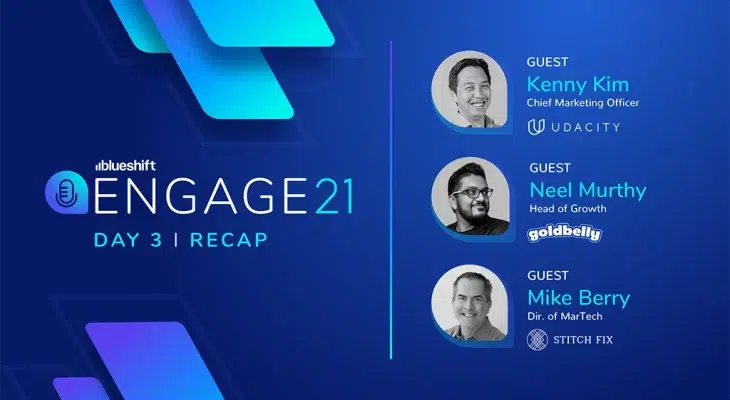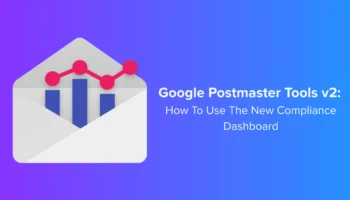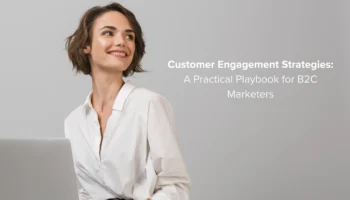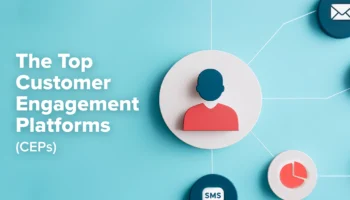We are already in the middle of a week chock full of marketing insights and every day is getting more and more insightful. On day 3 of Engage21, we covered stack and strategies for omnichannel marketing automation that connects the entire customer experience. We’ve learned from three marketing leaders how they’ve achieved success by using a CDP at the center of their technology and strategies to ensure the customer experience is consistent and friction-free.
The speakers for the third day were Kenny Kim (Chief Marketing Officer at Udacity), Neel Murthy (Head of Growth at Goldbelly), and Mike Berry (Head of Marketing Technology at Stitch Fix). The discussion was moderated by Josh Francia, our Chief Growth Officer at Blueshift.
Neel: “Both have their pros and cons. What I would suggest is thinking if you’re starting from scratch or not and if you have the technological expertise.”
Kenny: “At Udacity we have three go-to-market functions: one speaking to the individual learners, one work with enterprises to upskill their employees, and one working with actual country government entities. Salesforce is the lifeline for the enterprise sales team. And that has implications on how you build more context back there. On the consumer side, we’re heavily integrated with Blueshift. There are trade-offs around what you need to run the business? What are the priorities, the engineering team? Can they get things off the ground and how quickly can you stitch things together?”
Mike: “I would say that as time has gone by, the decision has leaned more towards integrating best of breed and away from monolithic stacks.”
So, everybody agreed that with the right technology team, a SmartHub CDP paired with best-of-breed technologies is the go-to solution for delivering engaging customer experiences across your omnichannel marketing initiatives.
About Martech and Stack
The discussion kicked off with everybody sharing their experiences of building a martech stack in a company where you either start from ground zero or you inherit it. That quickly led to a common question: what do you choose between monolithic type stacks or building a stack with a platform like Blueshift’s SmartHub CDP that can connect best-of-breed technologies? Is it better to have stacks that integrate with each other or go for a one size fits all approach where you have everything built out under one roof?
Neel: “Both have their pros and cons. What I would suggest is thinking if you’re starting from scratch or not and if you have the technological expertise.”
Kenny: “At Udacity we have three go-to-market functions: one speaking to the individual learners, one work with enterprises to upskill their employees, and one working with actual country government entities. Salesforce is the lifeline for the enterprise sales team. And that has implications on how you build more context back there. On the consumer side, we’re heavily integrated with Blueshift. There are trade-offs around what you need to run the business? What are the priorities, the engineering team? Can they get things off the ground and how quickly can you stitch things together?”
Mike: “I would say that as time has gone by, the decision has leaned more towards integrating best of breed and away from monolithic stacks.”
So, everybody agreed that with the right technology team, a SmartHub CDP paired with best-of-breed technologies is the go-to solution for delivering engaging customer experiences across your omnichannel marketing initiatives.
How Do You Align the Organization?
Technology, sales, finance are all big and important components of an organization. How do you align every piece and connect them to the customer experience? What are the speakers’ organizational strategies?
Kenny: “One is making sure the entire organization knows that growth is a company objective, not just a compartment objective. You may be responsible for the acquisition, or for branding, or you’re responsible for the full stack from acquisition to conversion, but even touchpoints like customer support or product experience have an impact on how the customer is going to view your brand. So it’s important to make clear we have a shared goal and make sure everyone is accountable for one top-line metric, and that everyone thinks about that holistically.”
Mike: “One of the things that I really admire about Stitch Fix is, we have these cross-functional initiatives that drive a vast majority of the work we do. We have leaders within different organizations who then get together with people across our data science teams, our engineering teams, our IT teams, our finance teams, to ensure that we’re all pursuing the same goal across these various initiatives.”
“I think it comes down to both communication and data to communicate properly across the organization. But the one thing I would add is that when you’re thinking about the customer experience for B2C companies, especially, you have to be obsessed with the highest standards to succeed because there are so many points of exposure that customers have.”
Neel Murthy, Head of Growth at Goldbelly
Connected teams, shared goals, data, and high standards. That sounds like a winning combination!
What Are The Metrics That Really Matter?
Let’s talk KPIs. Josh asked our guests: “What are the metrics that really matter when you’re trying to measure a consistent, cohesive, relevant customer experience?”
Mike: “The key metric for marketing is always going to be revenue. And I think one of the ones that are really becoming important these days is engagement. We really have to work with our customers to get to know them, understand them and their interests, and be able to communicate with them and establish relationship styles to trust in the brand. […] You have to have this engagement, you have to have this relevancy, you have to have this trust, you have to know how to reach people the way they want to be reached when they want to be reached.”
Kenny would also say engagement, but with an interesting observation: “I think engagement comes in different flavors. […] The final metric that we look at is engagement by cohort. There’s so much nuance that happens. Customers you acquired in May of this year will fundamentally look very different than customers acquired last year, because of COVID that happened last year. The circumstances of how they were acquired versus this cohort are different.”
Neel: “LTV becomes a lagging indicator. And what I’ve thought a lot about is in order to improve the LTV of our customers, by starting from NPS, but working down to retention by cohort, we’re able to really try to figure out earlier on with a metric-like time to second purchase. So it’s a quicker sort of segue into figuring out LTV, but it’s something very measurable by cohort. And I think that’s been pretty impactful for us.”
The conclusion? Our host Josh Francia summed it up: “You have to figure out what interactions and activities lead up to becoming an active customer and figure out how you can encourage those interactions, or make it easier for people to have those interactions so that you get higher LTV.”
What About the Future?
We couldn’t finish the conversation without asking our guests to put their prediction skills into good use. And the result of that not only impressed us but got us thinking about … you guessed it, the future! Predictable, right?
Kenny’s thoughts about the connected future gravitate around brand, content, and the innovative application of data. But he left us with this thought-provoking statement, that probably left some marketers thinking “ouch”:
“If you’re relying on just an out-of-the-box solution, you’re probably behind the times.”
Kenny Kim, Chief Marketing Officer at Udacity
If you happened to miss the first three days of Engage21, not to worry you can still register here to attend the rest of the conference.



